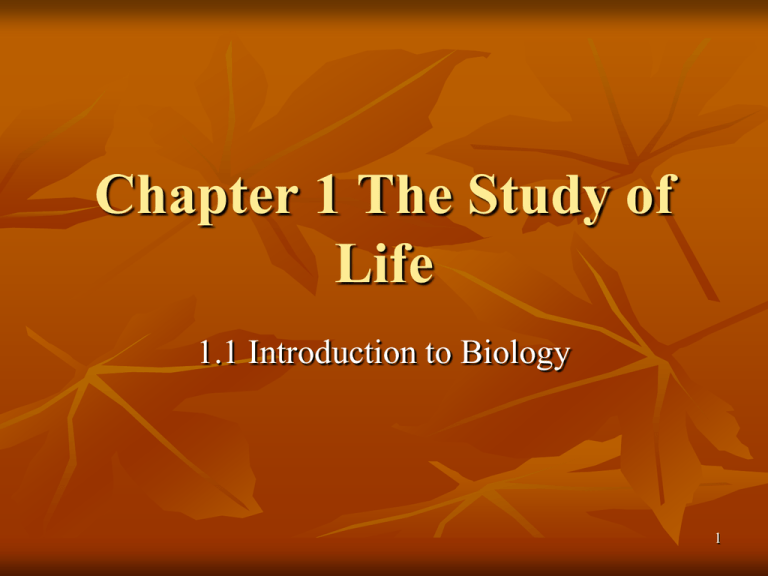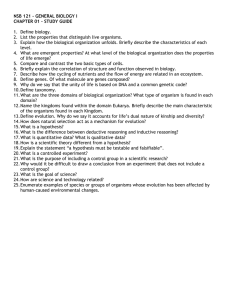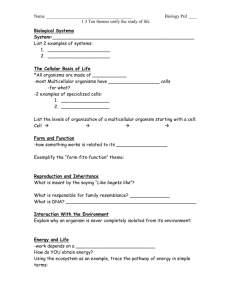Chapter 1 Biology: The Study of Life
advertisement

Chapter 1 The Study of Life 1.1 Introduction to Biology 1 Biology is the study of life There are many different types of living things; many (or most) haven’t been discovered yet. Snowy the albino echidna 2 Biology is the study of life In Biology you will study the features of living things and how they work. the interactions of living things with each other and the nonliving world. 3 What Biologists Do Study the diversity of life Research diseases Develop technologies Improve agriculture Preserve the environment 4 Characteristics of Living Things Alive or not? 5 Characteristics of Living Things Living things are made of cells. The cell is the basic unit of life. All living things are composed of one or more cells containing DNA (the hereditary material) that function in an organized way. 6 Characteristics of Living Things Living things display organization. Atoms form molecules, groups of molecules form cells, cells form tissues, different tissues working together form organs, organs working together form organ systems and organ systems working together to support an organism. Structure fits function is a major theme in biology. 7 Characteristics of Living Things Living things grow and develop. Growth is the addition of mass while development is the process of changes that occur throughout the life of an organism. 8 Characteristics of Living Things Living things reproduce. Organisms reproduce and pass along traits from one generation to the next. For a species to continue to exist, reproduction must occur. Reproduction can be asexual or sexual. 9 Characteristics of Living Things Living things respond to stimuli. All organisms live in constant interface with environment: air, water, weather, temperature, other organisms… 10 Characteristics of Living Things Stimulus: condition in the environment that causes an organism to adjust Response: reaction to a stimulus 11 Characteristics of Living Things Living things maintain homeostasis. Many responses organisms make are internal regulations make to maintain a “steady state” Homeostasis: maintaining steady state, takes energy. 12 Characteristics of Living Things Living things require energy. Energy is the ability to do work and is required for all life processes. Organisms get energy from food. Plants, some Protists, and some bacteria make their own food in the process of photosynthesis (producers). Animals, fungi, some Protists and some bacteria need to consume food (consumers). 13 Characteristics of Living Things In living things adaptations evolve over time. Adaptation are inherited changes that occur over time to enable an organism to respond to stimuli and better survive IN AN ENVIRONMENT. 14 Characteristics of Living Things Gradual accumulation of adaptations over time is EVOLUTION Fourth marking period we study evolution and find that some organisms evolve slowly (horse) while others evolve within our lifetime (bacteria). 15 A Systematic Approach The scientific method is a systematic approach used in scientific study, whether it is chemistry, physics, biology, or another science. It is an organized process used by scientists to do research, and provides methods for scientists to verify the work of others. A Systematic Approach (cont.) The steps in a scientific method are repeated until a hypothesis is supported or discarded. A Systematic Approach (cont.) An observation is the act of gathering information. – Qualitative data is obtained through observations that describe color, smell, shape, or some other physical characteristic that is related to the five senses. – Quantitative data is obtained from numerical observations that describe how much, how little, how big or how fast. A Systematic Approach (cont.) A hypothesis is a tentative explanation for what has been observed. An experiment is a set of controlled observations that test the hypothesis. A Systematic Approach (cont.) A variable is a quantity or condition that can have more than one value. – An independent variable is the variable you plan to change. – The dependent variable is the variable that changes in value in response to a change in the independent variable. A Systematic Approach (cont.) A control is a standard for comparison in the experiment. A conclusion is a judgment based on the information obtained from the experiment. – A hypothesis is never proven, only supported or discarded. – A model can be used to make predictions. Theory and Scientific Law A theory is an explanation that has been repeatedly supported by many experiments. – A theory states a broad principle of nature that has been supported over time by repeated testing. – Theories are successful if they can be used to make predictions that are true. Theory and Scientific Law (cont.) Section 1-3 A scientific law is a relationship in nature that is supported by many experiments, and no exceptions to these relationships are found.






